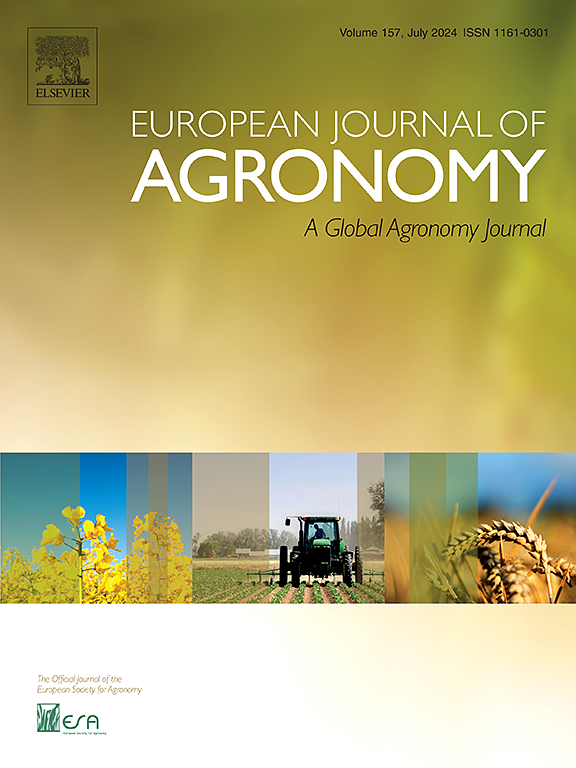Demonstrating almost half of cotton fiber quality variation is attributed to climate change using a hybrid machine learning-enabled approach
IF 4.5
1区 农林科学
Q1 AGRONOMY
引用次数: 0
Abstract
Understanding the effects of climate change on cotton fiber quality will reduce the risks to production caused by global warming. Machine learning algorithms are effective for forecasting climate impacts on crops. However, the impact of climate change on cotton fiber quality is unclear. Hence, a hybrid machine learning-enabled approach, the Bayesian model average (BMA) method with multiple machine learning algorithms (linear regressor, SVR, RFR, GBDT, LightGBM, and XGBoost) and bootstrap resampling, was developed to explore the impact and screen the important climatic factors affecting various traits of fiber quality. On the basis of fiber quality data from 1033 test stations across Xinjiang, China, from 2016 to 2022, the explained variance for climate change in the hybrid machine learning model was as follows: 44.72 %–50.55 % for white cotton grade, 44.06 %–53.95 % for length, 51.72 %–56.81 % for micronaire, 32.70 %–49.50 % for length uniformity, and 45.66 %–53.09 % for strength in the 1000 bootstrapping samples. In addition, recursive feature elimination with cross-validation (RFECV) was used to select the optimal feature set and calculate the contribution of each feature. The variability in micronaire in the hybrid model was affected primarily by climate factors, such as the daily minimum temperature, rainfall, and wind speed, whereas the other quality traits were affected mainly by radiation-related climatic indicators. The climate during the harvest stage in October had a significant effect on cotton quality, explaining 33.0 % of the variance in white cotton grade, 32.1 % in length, and 48.3 % in fiber strength. Conversely, the climate during the boll opening and early harvest stages in September had a greater influence on micronaire and length uniformity, accounting for 21.4 % and 37.2 % of the variance, respectively. This study highlights that climate change explains nearly 50 % of the variation in fiber quality, with the influence being notably more considerable during the later stages of the cotton growth period. These findings clarify the uncertainty in the impact of climate change on cotton fiber quality considering the uncertainty of the single machine model and model errors. Equally important, this information can be valuable for farmers and growers seeking to improve fiber quality under climate change.
利用混合机器学习方法证明近一半的棉花纤维质量变化归因于气候变化
了解气候变化对棉花纤维质量的影响将降低全球变暖对生产造成的风险。机器学习算法可有效预测气候对农作物的影响。然而,气候变化对棉花纤维质量的影响尚不明确。因此,我们开发了一种混合机器学习方法,即贝叶斯模型平均法(BMA),该方法采用多种机器学习算法(线性回归器、SVR、RFR、GBDT、LightGBM 和 XGBoost)和引导重采样,以探索影响并筛选出影响纤维质量各种性状的重要气候因素。基于 2016 年至 2022 年中国新疆 1033 个试验站的纤维质量数据,混合机器学习模型对气候变化的解释方差如下:在 1000 个引导样本中,白棉等级的解释方差为 44.72 %-50.55 %,长度的解释方差为 44.06 %-53.95 %,马克隆值的解释方差为 51.72 %-56.81 %,长度均匀性的解释方差为 32.70 %-49.50 %,强度的解释方差为 45.66 %-53.09 %。此外,还使用了交叉验证递归特征消除法(RFECV)来选择最佳特征集,并计算每个特征的贡献率。在混合模型中,马克隆值的变化主要受气候因素的影响,如日最低气温、降雨量和风速,而其他质量性状主要受辐射相关气候指标的影响。10 月份收获期的气候对棉花质量有显著影响,解释了 33.0 % 的白棉等级变异、32.1 % 的长度变异和 48.3 % 的纤维强度变异。相反,9 月棉铃开放和早期收获阶段的气候对棉花的细度和长度均匀性影响更大,分别占变异的 21.4% 和 37.2%。这项研究强调,气候变化可解释近 50% 的纤维质量变异,在棉花生长后期的影响尤其显著。考虑到单机模型的不确定性和模型误差,这些发现澄清了气候变化对棉花纤维质量影响的不确定性。同样重要的是,这些信息对于农民和种植者在气候变化条件下提高纤维质量具有重要价值。
本文章由计算机程序翻译,如有差异,请以英文原文为准。
求助全文
约1分钟内获得全文
求助全文
来源期刊

European Journal of Agronomy
农林科学-农艺学
CiteScore
8.30
自引率
7.70%
发文量
187
审稿时长
4.5 months
期刊介绍:
The European Journal of Agronomy, the official journal of the European Society for Agronomy, publishes original research papers reporting experimental and theoretical contributions to field-based agronomy and crop science. The journal will consider research at the field level for agricultural, horticultural and tree crops, that uses comprehensive and explanatory approaches. The EJA covers the following topics:
crop physiology
crop production and management including irrigation, fertilization and soil management
agroclimatology and modelling
plant-soil relationships
crop quality and post-harvest physiology
farming and cropping systems
agroecosystems and the environment
crop-weed interactions and management
organic farming
horticultural crops
papers from the European Society for Agronomy bi-annual meetings
In determining the suitability of submitted articles for publication, particular scrutiny is placed on the degree of novelty and significance of the research and the extent to which it adds to existing knowledge in agronomy.
 求助内容:
求助内容: 应助结果提醒方式:
应助结果提醒方式:


